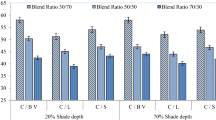Abstract
Angora rabbit fibre is one of the finest specialty animal fibres with its well-known reputation for fineness, lightness and softness. This study evaluated the Angora fibre shape and morphology in comparison with Cashmere fibre and wool as well as the relation between characteristics of Angora fibre. Unlike other keratinous textile fibres, single Angora fibre composes of two sections named as body and head, each of which has individual surface characteristics. Differences between the scale shapes, scale length and scale frequency of Angora hair types were explained in details. Medullation in Angora fibre was explained for different types of Angora hairs defined as down, awn and bristle. This classification was done according to the fibre fineness starting from the finer one. Relation between fibre shape and comfort factor was also analyzed. The relation between mean fibre diameter (MFD), fibre curvature (FC) and percentage of medullation by volume (MEDV) for Angora rabbit fibre was not as strong as wool and Cashmere fibre. Accordingly, when Angora hair types were analyzed individually, it was observed that relation between FC and MEDV for Angora fibre was stronger than wool and Cashmere fibre. Multiple regression analysis was also performed. Diameter distribution along the snippet length (about 200µm) of Angora fibre is uneven compared to Cashmere fibre and wool.
Similar content being viewed by others
References
L. Onal,Wool Technology Sheep Breeding,52(1), 18 (2004).
K. D. Langley and T. A. Kennedy,Text. Res. J.,11(11), 703 (1981).
S. Herrmann, G. Wortmann, and F. J. Wortmann,World Rabbit Science,4(3), 149 (1996).
H. M. Appleyard, “Guide to the Identification of Animal Fibres”, Wool Industrial Research Association, Leeds, UK, 1960.
J. L. Vrillon and R. G. Thebault, “4th World Rabbit Congress”, 10–14 October, Toulouse, France, 1988.
J. L. Vrillon and R. G. Thebault,J. Appl. Rabbit Res.,15, 1544 (1992).
S. Hatcher, “Cowra Sheep Symposium”, November, Part 3, 2002.
A. R. Edmunds, IWTO Meeting, Technical Report 19, Harrogate, UK, 1995.
C. J. Lupton and F. A. Pfeiffer,J. Animal Sci.,76, 1261 (1998).
L. Hunter, S. Smuts, and E. Gee,J. Text. Inst.,77(5), 336 (1986).
L. Hunter, S. Smuts, and L. Dorfling, IWTO Meeting, Technology and Standards Committee, Special Topics Group Appendix 4, 1996.
M. A. Brims and A. D. Peterson, IWTO Meeting, Technical report 21, New Delhi, India, 1994.
M. Safley, “The Role of Crimp in the Textile Process”, www.alpacas.com, 21 May 2006.
K. O. A. Kurdo, K. J. Whiteley, and L. J. Smith,J. Text. Inst.,77(2), 104 (1986).
M. Matsudaira, S. Kawabata, and M. Niwa,J. Text. Inst.,75(4), 267 (1984).
V. E. Fish,Wool Tech. Sheep Breed.,50(4), 792 (2002).
K. A. Hansford and W. Humphries, IWTO Meeting, Technical and Standard Committee, Report No 12, Nice, France, 1997.
V. E. Fish, T. J. Mahar, and B. J. Crook, IWTO Meeting, Technology and Standards Committee, Report No. CTF 01, Nice, France, 1999.
A. B. Wildman, “The Microscopy of Animal Textile Fibres”, WIRA, Leeds, UK, 1954.
R. H. Burns, W. von Bergen, and S. S. Young,J. Text. Inst.,53, T45 (1962).
X. Liu, L. J. Wang, and X. G. Wang,Text. Res. J.,74(3), 265 (2004).
X. Wang, M. Yao, K. Lai, and S. Liu,Journal of China Textile University (English Edition),17(1), 44 (2000).
D. J. Cheng and D. P. Huang,J. Appl. Rabbit Res.,15, 1629 (1992).
N. McLennan and R. Lewer, “Wool Production Coefficient of Variation of Fibre Diameter”, www.dpi.gld.gov.au, 01 June 2006.
R. K. Garnsworthy, R. L. Gully, R. P. Kandiah, P. Kenins, R. J. Mayfield, and R. A. Westerman, CSIRO, Textile and Fibre Technology Division, Report No. G64, 1968.
Author information
Authors and Affiliations
Corresponding author
Rights and permissions
About this article
Cite this article
Onal, L., Korkmaz, M. & Tutak, M. Relations between the characteristics of Angora rabbit fibre. Fibers Polym 8, 198–204 (2007). https://doi.org/10.1007/BF02875792
Received:
Revised:
Accepted:
Issue Date:
DOI: https://doi.org/10.1007/BF02875792




